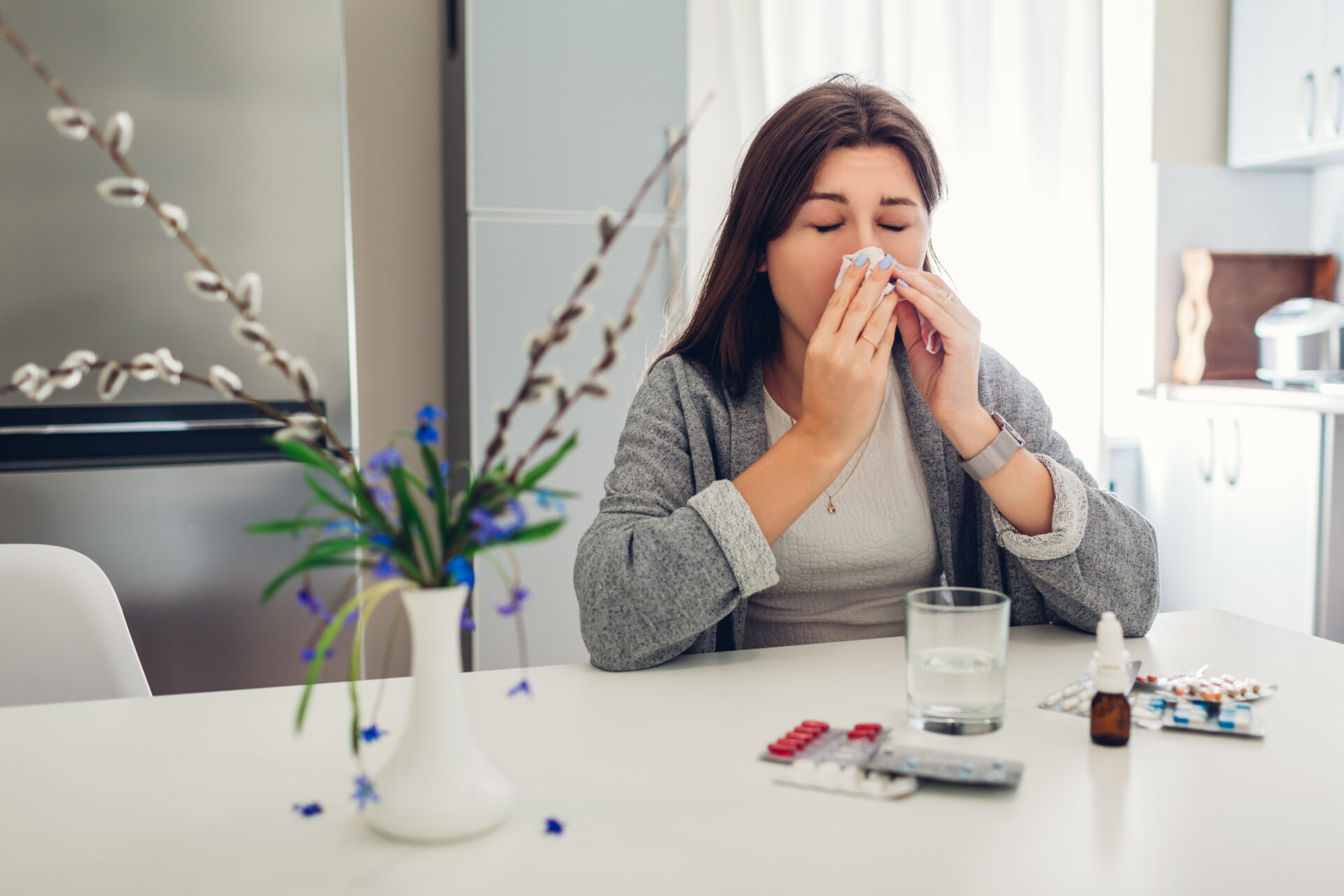Spring is the season of blooming flowers, warmer weather, and wonderful opportunities to enjoy the outdoors. Unfortunately, it also brings something less pleasant for many Americans: spring allergy or seasonal allergic rhinitis. These allergies affect 81 million adults and children in the United States each year, making it harder to fully enjoy the season.
The chief culprit behind these allergies is pollen, which is released into the air by trees, grasses, and weeds during this time of year. When people with allergies come into contact with pollen, their immune system goes into overdrive and results in symptoms like sneezing, stuffy nose, itchy eyes, and a scratchy throat.
But here’s a fact: spring allergies are not just a minor inconvenience. They can really put a damper on your quality of life by making it hard to focus on work, school, or simply enjoying your day.
What are Spring Allergies?
During the spring season, most plants release tiny particles called pollen into the air. For most people, these pollen particles are harmless. For those with spring or seasonal allergies, their immune system overreacts to the presence of pollen, perceiving it as a threat. This triggers an allergic reaction and leads to symptoms such as:
- Sneezing
- Runny or stuffy nose
- Watery, itchy, or red eyes (also known as allergic conjunctivitis)
- Itchy throat or ears
- Coughing
- Postnasal drip (sensation of mucus continually running down the back of your throat)
- Dark circles under the eyes
- Swelling around the eyes
- Fatigue
- Irritability or changes in mood due to discomfort
- Headaches
- Shortness of breath
- Wheezing or other asthma-like symptoms, especially after being outside
- Skin rashes, such as hives or eczema
- Sinus pressure or sinusitis
- Difficulty sleeping due to persistent symptoms
- An altered sense of taste or smell
- Ear infections or eustachian tube dysfunction in children
If you are allergic to pollen and you breathe it in, your immune system mistakenly identifies it as harmful and produces antibodies to fight it off. These antibodies then trigger the release of chemicals, such as histamine, into the bloodstream. Histamine is responsible for causing the characteristic symptoms of spring allergies, including sneezing, itching, congestion, and watery eyes.
Of course, different plants release different types of pollen, and the specific type of pollen that triggers an allergic reaction can vary from person to person. Some people are more sensitive to tree pollen, while others react more strongly to grass or weed pollen.
The severity and range of symptoms can also vary. If you or someone you know is experiencing the allergy symptoms listed above, visit your nearest Exer urgent care clinic for same-day treatment. For severe symptoms such as difficulty breathing or severe skin reactions, head over to your nearest emergency room or primary care provider as soon as possible.
Most Common Spring Allergy Triggers in California
From the blossoming trees to the sprouting grasses, there are several natural elements that can act as allergy triggers, and manifest in symptoms ranging from mildly irritating to severely debilitating.
Oak Trees
With over twenty different species of oak trees native to California, these trees are a common sight in both urban and rural landscapes. In spring, the trees release tiny, light pollen grains that are easily carried by the wind. This easy circulation (dispersion) is what makes them such a potent allergy trigger. If you are allergic to oak tree pollen, you may experience symptoms like sneezing, itchy, watery eyes, and a runny or congested nose.
Cedar Trees
While there are different varieties of cedar trees, Mountain Cedar, also known as Ashe Juniper, is particularly notorious among allergy sufferers. Found in the central regions of California, these trees release pollen in the cooler late winter and early spring months. The pollen is so potent it can cause severe allergic reactions, including an itchy, runny nose, sneezing, nasal blockage and sometimes even a fever, a condition often referred to as “cedar fever.”
Pine Trees
In the mountainous regions of California (like the Sierra Nevada, the Cascade Range, and the Coast Ranges), pine trees are pretty common. While their pollen is generally not as allergenic as other types, the sheer volume of pollen they produce in the spring can cause symptoms if you are extremely sensitive. The symptoms include sneezing, itchy eyes, and a scratchy throat.
Bermuda Grass
Thriving in the warm and pleasant California climate, Bermuda grass is one of the common culprits of spring to early fall allergies. When the seasons change, this grass starts releasing pollen, and that’s when the trouble begins.
The pollen from Bermuda grass is very tiny and light. It gets picked up by the wind and can travel long distances. When people breathe in this pollen during the allergy season, they can start experiencing sneezing fits, sniffles, and red, itchy eyes. Since the wind carries the pollen all around, it makes it really hard to escape.
Timothy Grass
A common type of hay used for animal feed; Timothy grass is found in many regions of California. It starts blooming in the early summer and releases lightweight pollen that can travel great distances with the wind. The pollen often triggers hay fever symptoms like itchy eyes, sneezing, and throat irritation.
Ragweed
While it blooms later in the summer and fall, ragweed is also a significant cause of hay fever. Its lightweight pollen can travel vast distances and considering that even a single plant can produce a billion grains of pollen per season, it can lead to severe allergy symptoms like prolonged sneezing, nasal congestion, and itchy skin.
Privet
Privet plants are commonly used as beautiful hedges in gardens and landscapes to add a touch of charm. Moreover, during late spring, these plants also release a lot of pollen. The small white flowers of privet plants may look innocent, but their pollen can spell real trouble to allergy sufferers. The most common allergy symptoms associated with privet pollen are stuffy nose, watery eyes, and sneezing fits.
Pampas Grass
Originally from South America, Pampas grass is a common sight in California due to its attractive, feathery plumes. In relation to this, these plumes release a large amount of pollen, which can trigger allergic reactions and symptoms like a stuffy nose, itchy throat, and watery eyes.
Your Treatment Options to Fight Spring Allergies
Depending on the cause and severity of your allergy, there are several treatments that doctors may prescribe to manage and alleviate your symptoms, including:
Antihistamines
These medicines work to neutralize the effect of histamine, a compound that the body releases in response to allergens and causes classic symptoms like itching, sneezing, and a runny nose. Antihistamines can help alleviate these symptoms, and many of them are readily available over the counter. You may be prescribed loratadine (Claritin), which offers 24-hour non-drowsy relief; cetirizine (Zyrtec), known for its fast-acting property; and fexofenadine (Allegra), which also provides 24-hour relief without causing drowsiness.
Nasal Corticosteroids
These are nose sprays that help reduce inflammation in your nasal passages, a common reaction to allergens. They are known for relieving symptoms like nasal congestion, sneezing, and a runny nose. Nasal sprays for allergies come in many varieties, including but not limited to:
- Fluticasone (Flonase) reduces inflammation and swelling in the nasal passages
- Budesonide (Rhinocort) soothes and heals inflamed nasal tissue
- Mometasone (Nasonex) alleviates both the immediate and long-term effects of nasal allergy symptoms
Decongestants
Decongestants are designed to relieve nasal congestion by shrinking swollen blood vessels in your nasal passages so you can breathe easier. Pseudoephedrine (Sudafed) is a popular decongestant; phenylephrine (Neo-Synephrine) is another option available as a spray for quick and direct relief.
Leukotriene Inhibitors
This category of medication targets leukotrienes, i.e., chemicals your body releases when you come in contact with an allergen like pollen, dust mites, or pet dander. These leukotrienes bind to certain cells in your body and cause inflammation and swelling in the airways, thereby producing excess mucus. Leukotriene inhibitors are medications that block this action and help reduce the symptoms of allergies.
Allergy Shots (Immunotherapy)
If your allergies are too severe or chronic, our urgent care providers may recommend allergy shots. You will receive regular injections of a small number of allergens that cause your symptoms. The goal is to progressively accustom your immune system to these allergens, ultimately making it less reactive and reducing your symptoms over time.
Eye Drops
For symptoms like itchy or watery eyes, often accompanying spring allergies, your doctor might suggest eye drops. Many of these drops have antihistamines or other medications to counter allergy symptoms.
Nasal Irrigation
Though not an allergy medicine, some doctors recommend nasal irrigation, such as with a neti pot, to clear out mucus and allergens from the nasal passages. This natural method uses a saline solution to gently cleanse the nasal lining and alleviate congestion, runny nose, and other symptoms.
Each of the options for treating allergies plays a unique role in managing allergy symptoms. Depending on how serious your symptoms are or what’s causing them, you may be prescribed one or a combination of these allergy medications.
Manage Your Spring Allergies with These Simple Tips
Our healthcare providers at Exer Urgent Care recommend these tips for managing your seasonal allergy symptoms:
- Keep an eye on local weather reports for pollen forecasts. Try to stay indoors on high pollen days.
- Keep windows closed during high pollen times to avoid letting the allergens into your home.
- Using air conditioning can filter out pollen and other allergens from your indoor air.
- Avoid hanging clothes or bedding out to dry. Pollen can cling to these items.
- Try to schedule outdoor activities for later in the day as pollen counts are usually highest in the morning.
- Wear sunglasses when you go out to protect your eyes from airborne allergens.
- Shower and change clothes after being outside to remove pollen from your skin and hair.
- Consider using a dehumidifier to reduce moisture that can encourage the growth of mold, another potential allergy trigger.
- Regularly clean your home to reduce allergens. Pay particular attention to areas where they might accumulate like carpets and upholstery.
- Consider investing in a high-efficiency particulate air (HEPA) filter to remove allergens from the air.
- Try to keep pets from bringing in pollen by wiping their paws and fur when they come inside.
- Avoid mowing the lawn or raking leaves, which can stir up pollen and mold.
- Keep car windows up and use the air conditioning when driving to prevent pollen from entering the car.
- Regular exercise can boost your immune system and potentially reduce allergy symptoms. Just try to do so indoors on high pollen days.
- Staying well-hydrated can help your body better cope with the effects of allergies.
- Over-the-counter saline sprays can help soothe a dry, irritated nose.
- Consider wearing a pollen mask for outdoor chores when you can’t avoid them on high pollen days.
- Try not to rub your eyes, which can exacerbate symptoms. If your eyes are itchy, use a cold compress instead.
Exer Offers Customized Seasonal Allergy Treatment Plans
Allergies are not just annoying – they can disrupt your daily routine and leave you feeling miserable! At Exer Urgent Care, we understand the impact allergies can have, and we are here to help. With 60+ locations across Southern California, quality urgent care services are always within reach. Our urgent care clinics have extended hours, open seven days a week, so you don’t have to wait or suffer through a sleepless night before seeking relief.
When it comes to managing your seasonal allergies, we know that time is of the essence. That’s why we offer walk-in care, so you get the attention you need as soon as you start experiencing symptoms. Thanks to our on-site, fully equipped diagnostics lab, we can conduct allergy testing right as you walk in, determine the cause of your allergies, and start your treatment without delay.
No more waiting for days to confirm your condition. With our quick turnaround, you will spend less time suffering and more time on the path to recovery. Go to your nearest Exer Urgent Care clinic today and let us help you get back on your feet.































































